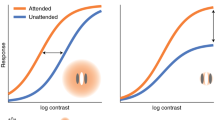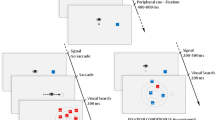Abstract
Visual attention is essential for visual perception. Spatial attention allows us to grant priority in processing and selectively process information at a given location. In this paper, I explain how two kinds of spatial attention: covert (allocated to the target location, without accompanying eye movements) and presaccadic (allocated to the location of the upcoming saccade’s target) affect performance and alter appearance. First, I highlight some behavioral and neuroimaging research on covert attention, which alters performance and appearance in many basic visual tasks. Second, I review studies showing that presaccadic attention improves performance and alters appearance at the saccade target location. Further, these modulations change the processing of feature information automatically, even when it is detrimental to the task at hand. We propose that saccade preparation may support transsaccadic integration. Systematically investigating the common and differential characteristics of covert attention and presaccadic attention will continue to further our understanding of the pervasive selective processing of information, which enables us to make sense of our complex visual world.



(Reprinted from Li et al., Fig. 4)

(Reproduced with permission from Li et al. 2018)
Similar content being viewed by others
References
Ahumada AJ (2002) Classification image weights and internal noise level estimation. J Vis 2(1):121–131
Anton-Erxleben K, Carrasco M (2013) Attentional enhancement of spatial resolution: linking behavioural and neurophysiological evidence. Nat Rev Neurosci 14(3):188–200
Anton-Erxleben K, Abrams J, Carrasco M (2010) Evaluating comparative and equality judgments in contrast perception: attention alters appearance. J Vis 10(11):1–22
Anton-Erxleben K, Abrams J, Carrasco M (2011) Equality judgments cannot distinguish between attention effects on appearance and criterion: a reply to Schneider. J Vis 11(13):1–8
Barbot A, Landy MS, Carrasco M (2011) Exogenous attention enhances 2nd-order contrast sensitivity. Vis Res 51:1086–1098
Barbot A, Landy MS, Carrasco M (2012) Differential effects of exogenous and endogenous attention on second-order texture contrast sensitivity. J Vis 12(8):1–15
Bisley JW, Goldberg ME (2010) Attention, intention, and priority in the parietal lobe. Annu Rev Neurosci 33:1–21
Bocanegra BR, Zeelenberg R (2011) Emotion-induced trade-offs in spatiotemporal vision. J Exp Psychol Gen 140(2):272–282
Boynton GM, Demb JB, Glover GH, Heeger DJ (1999) Neuronal basis of contrast discrimination. Vis Res 39(2):257–269
Cameron EL, Tai JC, Carrasco M (2002) Covert attention affects the psychometric function of contrast sensitivity. Vis Res 42(8):949–967
Carrasco M (2006) Covert attention increases contrast sensitivity: psychophysical, neurophysiological and neuroimaging studies. Prog Brain Res 154:33–70
Carrasco M (2011) Visual attention: the past 25 years. Vision Res 51(13):1484–1525
Carrasco M (2014) Spatial attention: perceptual modulation. In: Kastner S, Nobre AC (eds) The oxford handbook of attention. Oxford University Press, Oxford, pp 183–230
Carrasco M, Barbot A (2015) How attention affects spatial resolution. Cold Spring Harb Symp Quant Biol 79:149–160
Carrasco M, Yeshurun Y (2009) Covert attention effects on spatial resolution. Prog Brain Res 176:65–86
Carrasco M, Penpeci-Talgar C, Eckstein M (2000) Spatial covert attention increases contrast sensitivity across the CSF: support for signal enhancement. Vis Res 40(10–12):1203–1215
Carrasco M, Giordano AM, McElree B (2004a) Temporal performance fields: visual and attentional factors. Vis Res 44(12):1351–1365
Carrasco M, Ling S, Read S (2004b) Attention alters appearance. Nat Neurosci 7(3):308–313
Carrasco M, Giordano AM, McElree B (2006a) Attention speeds processing across eccentricity: feature and conjunction searches. Vis Res 46(13):2028–2040
Carrasco M, Loula F, Ho YX (2006b) How attention enhances spatial resolution: evidence from selective adaptation to spatial frequency. Percept Psychophys 68(6):1004–1012
Carrasco M, Fuller S, Ling S (2008) Transient attention does increase perceived contrast of suprathreshold stimuli: a reply to Prinzmetal, Long and Leonhardt. Percept Psychophys 70(7):1151–1164
Castet E, Jeanjean S, Montagnini A, Laugier D, Masson G (2006) Dynamics of attentional deployment during saccadic programming. J Vis 6:196–212
Cutrone EK, Heeger DJ, Carrasco M (2014) Attention enhances contrast appearance via increased input baseline of neural responses. J Vis 14(14):16
De Valois RL, De Valois KK (1988) Spatial vision. Oxford University Press, Oxford, p 1988
Deubel H (2008) The time course of presaccadic attention shifts. Psychol Res 72:630–640
Deubel H, Schneider WX (1996) Saccade target selection and object recognition: evidence for a common attentional mechanism. Vis Res 36(12):1827–1837
Di Russo F, Spinelli D, Morrone MC (2001) Automatic gain control contrast mechanisms are modulated by attention in humans: evidence from visual evoked potentials. Vis Res 41(19):2435–2447
Fuller S, Rodriguez RZ, Carrasco M (2008) Apparent contrast differs across the vertical meridian: visual and attentional factors. J Vis 8(1):1–16
Fuller S, Park Y, Carrasco M (2009) Cue contrast modulates the effects of exogenous attention on appearance. Vis Res 49(14):1825–1837
Giordano AM, McElree B, Carrasco M (2009) On the automaticity and flexibility of covert attention: a speed-accuracy trade-off analysis. J Vis 9(3):1–10
Graham N (1989) Visual pattern analyzers. Oxford University Press, New York
Grubb MA, Behrmann M, Egan R, Minshew NJ, Carrasco M, Heeger DJ (2013a) Endogenous spatial attention: evidence for intact functioning in adults with autism. Autism Res 6(2):108–118
Grubb MA, Behrmann M, Egan R, Minshew NJ, Heeger DJ, Carrasco M (2013b) Exogenous spatial attention: evidence for intact functioning in adults with autism spectrum disorder. J Vis 13(14):1–13
Hein E, Rolke B, Ulrich R (2006) Visual attention and temporal discrimination: differential effects of automatic and voluntary cueing. Vis Cogn 13(1):29–50
Herrmann K, Montaser-Kouhsari L, Carrasco M, Heeger DJ (2010) When size matters: attention affects performance by contrast or response gain. Nat Neurosci 13(12):1554–1559
Huang L, Dobkins KR (2005) Attentional effects on contrast discrimination in humans: evidence for both contrast gain and response gain. Vis Res 45(9):1201–1212
Kinchla RA (1980) The measurement of attention. In: Nickerson R (ed) Attention and performance VIII. Princeton, Psychology Press, pp 213–238
Kowler E, Anderson E, Dosher B, Blaser E (1995) The role of attention in the programming of saccades. Vis Res 35(13):1897–1916
Lennie P (2003) The cost of cortical computation. Curr Biol 13(6):493–497
Li H-H, Barbot A, Carrasco M (2016) Saccade preparation reshapes sensory tuning. Curr Biol 26(12):1564–1570
Li H-H, Pan J, Carrasco M (2018) Presaccadic attention reshapes sensory information even when it impairs performance. In: Vision Science Society's abstract book (abstract)
Ling S, Carrasco M (2006a) Sustained and transient covert attention enhance the signal via different contrast response functions. Vis Res 46(8–9):1210–1220
Ling S, Carrasco M (2006b) When sustained attention impairs perception. Nat Neurosci 9(10):1243–1245
Ling S, Carrasco M (2007) Transient covert attention does alter appearance: a reply to Schneider (2006). Percept Psychophys 69(6):1051–1058
Liu T, Stevens ST, Carrasco M (2007) Comparing the time course and efficacy of spatial and feature-based attention. Vis Res 47(1):108–113
Liu T, Abrams J, Carrasco M (2009) Voluntary attention enhances contrast appearance. Psychol Sci 20(3):354–362
Lu ZL, Dosher BA (1998) External noise distinguishes attention mechanisms. Vis Res 38(9):1183–1198
Luck SJ (2004) Understanding awareness: one step closer. Nat Neurosci 7(3):208–209
Luck SJ, Hillyard SA, Mouloua M, Woldorff MG, Clark VP, Hawkins HL (1994) Effects of spatial cuing on luminance detectability: psychophysical and electrophysiological evidence for early selection. J Exp Psychol Hum Percept Perform 20(4):887–904
Mangun GR, Hillyard SA (1990) Allocation of visual attention to spatial locations: tradeoff functions for event-related brain potentials and detection performance. Percept Psychophys 47(6):532–550
Montagna B, Pestilli F, Carrasco M (2009) Attention trades off spatial acuity. Vis Res 49(7):735–745
Montagnini A, Castet E (2007) Spatiotemporal dynamics of visual attention during saccade preparation: independence and coupling between attention and movement planning. J Vis 7(8):1–16
Moore T, Zirnsak M (2017) Neural mechanisms of selective visual attention. Annu Rev Psychol 68:47–72
Morrone MC, Denti V, Spinelli D (2002) Color and luminance contrasts attract independent attention. Curr Biol 12(13):1134–1137
Morrone MC, Denti V, Spinelli D (2004) Different attentional resources modulate the gain mechanisms for color and luminance contrast. Vis Res 44(12):1389–1401
Muller HJ, Rabbitt PM (1989) Spatial cueing and the relation between the accuracy of “where” and “what” decisions in visual search. Q J Exp Psychol 41(4):747–773
Nachmias J (1967) Effect of exposure duration on visual contrast sensitivity with square-wave gratings. J Opt Soc Am 57(3):421–427
Nakayama K, Mackeben M (1989) Sustained and transient components of focal visual attention. Vis Res 29(11):1631–1647
Pestilli F, Carrasco M (2005) Attention enhances contrast sensitivity at cued and impairs it at uncued locations. Vis Res 45(14):1867–1875
Pestilli F, Viera G, Carrasco M (2007) How do attention and adaptation affect contrast sensitivity? J Vis 7(7):1–12
Pestilli F, Ling S, Carrasco M (2009) A population-coding model of attention’s influence on contrast response: estimating neural effects from psychophysical data. Vis Res 49(10):1144–1153
Poletti M, Listorti C, Rucci M (2013) Microscopic eye movements compensate for nonhomogeneous vision within the fovea. Curr Biol 23(17):1691–1695
Poletti M, Rucci M, Carrasco C (2017) Selective attention within the foveola. Nat Neurosci 20(10):1413–1417
Remington RW, Johnston JC, Yantis S (1992) Involuntary attentional capture by abrupt onsets. Percept Psychophys 51(3):279–290
Reynolds JH, Heeger DJ (2009) The normalization model of attention. Neuron 61(2):168–185
Reynolds JH, Pasternak T, Desimone R (2000) Attention increases sensitivity of V4 neurons. Neuron 26(3):703–714
Ringach DL, Hawken MJ, Shapley R (1997) Dynamics of orientation tuning in macaque primary visual cortex. Nature 387(6630):281–284
Roberts M, Cymerman R, Smith RT, Kiorpes L, Carrasco M (2016) Covert spatial attention is functionally intact in amblyopic human adults. J Vis 16(15):1–19
Roberts M, Ashinoff BK, Castellanos FX, Carrasco M (2017) When attention is intact in adults with ADHD. Psychon Bull Rev 24(6):1–12
Rolfs M, Carrasco M (2012) Rapid simultaneous enhancement of visual sensitivity and perceived contrast during saccade preparation. J Neurosci 32(40):13744–13752a
Rolfs M, Jonikaitis D, Deubel H, Cavanagh P (2011) Predictive remapping of attention across eye movements. Nat Neurosci 14:252–256
Skottun BC, Bradley A, Sclar G, Ohzawa I, Freeman RD (1987) The effects of contrast on visual orientation and spatial frequency discrimination: a comparison of single cells and behavior. J Neurophysiol 57(3):773–786
Sperling G, Melchner MJ (1978) The attention operating characteristic: examples from visual search. Science 202(4365):315–318
Talgar CP, Carrasco M (2002) Vertical meridian asymmetry in spatial resolution: visual and attentional factors. Psychon Bull Rev 9(4):714–722
Treue S (2004) Perceptual enhancement of contrast by attention. Trends Cogn Sci 8(10):435–437
Treue S, Maunsell JH (1999) Effects of attention on the processing of motion in macaque middle temporal and medial superior temporal visual cortical areas. J Neurosci 19(17):7591–7602
Williford T, Maunsell JH (2006) Effects of spatial attention on contrast response functions in macaque area V4. J Neurophysiol 96(1):40–54
Wyart V, Nobre AC, Summerfield C (2012) Dissociable prior influences of signal probability and relevance on visual contrast sensitivity. Proc Natl Acad Sci USA 109(9):3593–3598
Yantis S, Jonides J (1996) Attentional capture by abrupt onsets: new perceptual objects or visual masking? J Exp Psychol Hum Percept Perform 22(6):1505–1513
Yeshurun Y, Carrasco M (1998) Attention improves or impairs visual performance by enhancing spatial resolution. Nature 396(6706):72–75
Yeshurun Y, Carrasco M (2000) The locus of attentional effects in texture segmentation. Nat Neurosci 3(6):622–627
Yeshurun Y, Carrasco M (2008) The effects of transient attention on spatial resolution and the size of the attentional cue. Percept Psychophys 70(1):104–113
Yeshurun Y, Levy L (2003) Transient spatial attention degrades temporal resolution. Psychol Sci 14(3):225–231
Yeshurun Y, Rashal E (2010) Precueing attention to the target location diminishes crowding and reduces the critical distance. J Vis 10(10):16
Author information
Authors and Affiliations
Corresponding author
Rights and permissions
About this article
Cite this article
Carrasco, M. How visual spatial attention alters perception. Cogn Process 19 (Suppl 1), 77–88 (2018). https://doi.org/10.1007/s10339-018-0883-4
Published:
Issue Date:
DOI: https://doi.org/10.1007/s10339-018-0883-4










